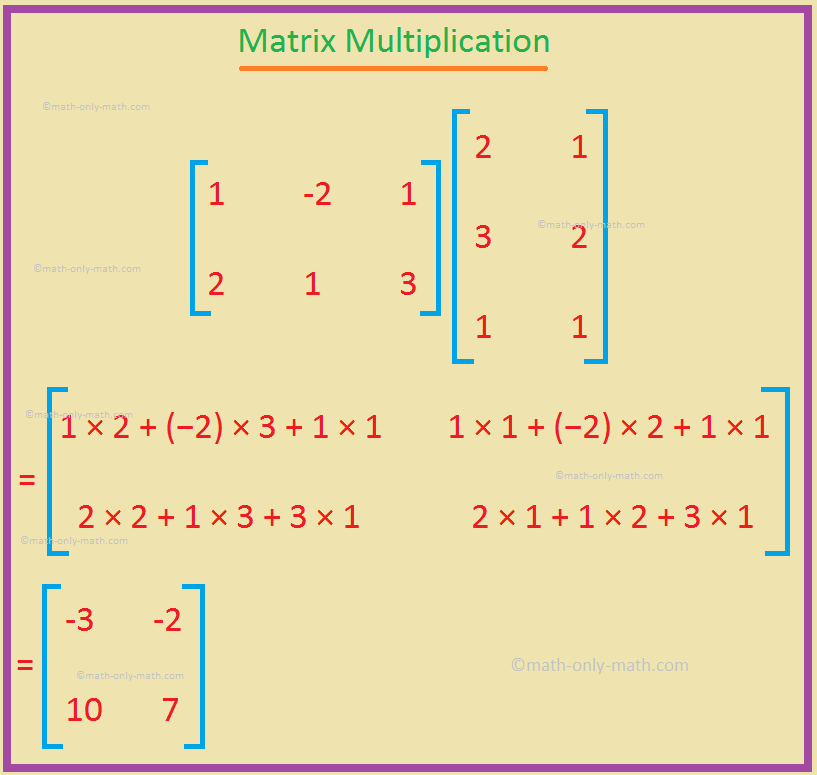Subscribe to our ▶️ YouTube channel 🔴 for the latest videos, updates, and tips.
Problems on Matrix Multiplication
Here we will solve different types of Problems on Matrix Multiplication.
1. If A = \(\begin{bmatrix} 1 & -2 & 1\\ 2 & 1 & 3 \end{bmatrix}\) and B = \(\begin{bmatrix} 2 & 1\\ 3 & 2\\ 1 & 1 \end{bmatrix}\), write down the matrix AB. Would it be possible to find the product of BA? If so, compute it, and if not, give reasons.
Solutions:
Here, matrix A is of the order 2 × 3 and matrix B is of the order 3 × 2.
So, the number of columns in A = the number of rows in B = 3.
So, AB can found.
AB = \(\begin{bmatrix} 1 & -2 & 1\\ 2 & 1 & 3 \end{bmatrix}\)\(\begin{bmatrix} 2 & 1\\ 3 & 2\\ 1 & 1 \end{bmatrix}\)
= \(\begin{bmatrix} 1 \times 2 + (-2) \times 3 + 1 \times 1 & 1 \times 1 + (-2) \times 2 + 1 \times 1\\ 2 \times 2 + 1 \times 3 + 3 \times 1 & 2 \times 1 + 1 \times 2 + 3 \times 1 \end{bmatrix}\)
= \(\begin{bmatrix} -3 & -2\\ 10 & 7 \end{bmatrix}\), which is a matrix of the order 2 × 2.
Now, the number of columns in B = the number of rows in A =
2. So, BA can be found, and the order of BA is 3 × 3.
BA = \(\begin{bmatrix} 2 & 1\\ 3 & 2\\ 1 & 1 \end{bmatrix}\)\(\begin{bmatrix} 1 & -2 & 1\\ 2 & 1 & 3 \end{bmatrix}\)
= \(\begin{bmatrix} 2 \times 1 + 1 \times 2 & 2 \times (-2) + 1 \times 1 & 2 \times 1 + 1 \times 3\\ 3 \times 1 + 2 \times 2 & 3 \times (-2) + 2 \times 1 & 3 \times 1 + 2 \times 3 \\ 1 \times 1 + 1 \times 2 & 1 \times (-2) + 1 \times 1 & 1 \times 1 + 1 \times 3 \end{bmatrix}\)
= \(\begin{bmatrix} 4 & -3 & 5\\ 7 & -4 & 9\\ 3 & -1 & 4 \end{bmatrix}\)
Clearly, we can see that AB ≠ BA because they are not of the same order.
2. Let A = \(\begin{bmatrix} 2 cos 60^{\circ} & -2 sin^{\circ}\\ -tan 45^{\circ} & cos 0^{\circ} \end{bmatrix}\) and B = \(\begin{bmatrix} cot 45^{\circ} & csc 30^{\circ}\\ sec 60^{\circ} & sin 90^{\circ} \end{bmatrix}\). Evaluate AB.
Solution:
AB = \(\begin{bmatrix} 2 cos 60^{\circ} & -2 sin^{\circ}\\ -tan 45^{\circ} & cos 0^{\circ} \end{bmatrix}\)\(\begin{bmatrix} cot 45^{\circ} & csc 30^{\circ}\\ sec 60^{\circ} & sin 90^{\circ} \end{bmatrix}\)
= \(\begin{bmatrix} 2 \cdot \frac{1}{2} & -2 \cdot \frac{1}{2}\\ -1 & 1 \end{bmatrix}\)\(\begin{bmatrix} -1 & 1\\ 1 & -1 \end{bmatrix}\)
= \(\begin{bmatrix} 1 & -1\\ -1 & 1 \end{bmatrix}\)\(\begin{bmatrix} 1 & 2\\ 2 & 1 \end{bmatrix}\)
= \(\begin{bmatrix} 1 \times 1 + (-1) \times 2 & 1 \times 2 + (-1) \times 1\\ (-1) \times 1 + 1 \times 2 & (-1) \times 2 + 1 \times 1 \end{bmatrix}\)
= \(\begin{bmatrix} -1 & 1\\ 1 & -1 \end{bmatrix}\).
3. If A = \(\begin{bmatrix} 1 & 2\\ 2 & 1 \end{bmatrix}\) and B = \(\begin{bmatrix} 2 & 1\\ 1 & 2 \end{bmatrix}\), find A(BA).
Solution:
BA = \(\begin{bmatrix} 2 & 1\\ 1 & 2 \end{bmatrix}\)\(\begin{bmatrix} 1 & 2\\ 2 & 1 \end{bmatrix}\)
= \(\begin{bmatrix} 2 \times 1 + 1 \times 2 & 2 \times 2 + 1 \times 1\\ 1 \times 1 + 2 \times 2 & 1 \times 2 + 2 \times 1 \end{bmatrix}\)
= \(\begin{bmatrix} 4 & 5\\ 5 & 4 \end{bmatrix}\).
Therefore, A(BA) = \(\begin{bmatrix} 1 & 2\\ 2 & 1 \end{bmatrix}\)\(\begin{bmatrix} 4 & 5\\ 5 & 4 \end{bmatrix}\)
= \(\begin{bmatrix} 1 \times 4 + 2 \times 5 & 1 \times 5 + 2 \times 4\\ 2 \times 4 + 1 \times 5 & 2 \times 5 + 1 \times 4 \end{bmatrix}\)
= \(\begin{bmatrix} 14 & 13\\ 13 & 14 \end{bmatrix}\)
From Problems on Matrix Multiplication to HOME PAGE
Didn't find what you were looking for? Or want to know more information about Math Only Math. Use this Google Search to find what you need.



New! Comments
Have your say about what you just read! Leave me a comment in the box below. Ask a Question or Answer a Question.